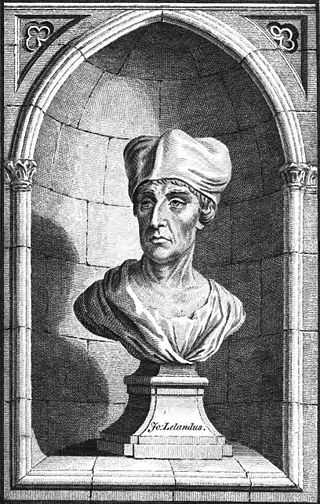
John Leland or Leyland was an English poet and antiquary.

Thomas Hearne or Hearn was an English diarist and prolific antiquary, particularly remembered for his published editions of many medieval English chronicles and other important historical texts.

Anthony Wood, who styled himself Anthony à Wood in his later writings, was an English antiquary. He was responsible for a celebrated Hist. and Antiq. of the Universitie of Oxon.

Edmond Malone was an Irish barrister, Shakespearean scholar and editor of the works of William Shakespeare.
AM 738 4to, Edda oblongata or Langa Edda, is a late 17th-century Icelandic paper manuscript currently housed in the Árni Magnússon Institute for Icelandic Studies, Reykjavík. The manuscript is most notable for its distinct oblong format and the numerous colorful illustrations it contains.
Oxford, Bodleian Library, Rawlinson B 502 is a medieval Irish manuscript which currently resides in the Bodleian Library, Oxford. It ranks as one of the three major surviving Irish manuscripts to have been produced in pre-Norman Ireland, the two other works being the Lebor na hUidre and the Book of Leinster. Some scholars have also called it the Book of Glendalough, in Irish Lebar Glinne Dá Locha, after several allusions in medieval and early modern sources to a manuscript of that name. However, there is currently no agreement as to whether Rawlinson B 502, more precisely its second part, is to be identified as the manuscript referred to by that title.

John Rouse was an English librarian. He was the second librarian of the Bodleian in Oxford, as well as a friend of John Milton.
Francis Mason (c.1566–1621) was an English churchman, archdeacon of Norfolk and author of Of the Consecration of the Bishops in the Church of England (1613), a defence of the Church of England and the first serious rebuttal of the Nag's Head Fable put about as denigration of Matthew Parker and Anglican orders.
Abraham Hartwell, the younger (1553/4–1606), was an English translator and antiquary, and Member of Parliament. Another Abraham Hartwell of the period was also an author, publishing Regina Literata in 1564, and the two have in the past been confused.
Francis Sabie was an English poet.

Patrick Anderson, was a physician and author.

Miles Huggarde or Myles Hogarde, was an English religious pamphleteer and opponent of the Protestant Reformation. He has been described as the best of Roman Catholic propagandists in the bitter pamphlet war of 1553–1558 during the reign of Queen Mary I.
John Andrews, was an English poet.
William Forrest was an English Catholic priest and poet.
Abraham Portal was an English goldsmith and dramatist.

Francis Webb was an English writer.
Thomas Harman was an English writer best known for his seminal work on beggars, A Caveat or Warning for Common Cursitors.
Samuel Sheppard was an English author and poet of the Civil War who sometimes published under the anagrammatic pseudonym Raphael Desmus.
Alexander Gil the younger, also spelled Gill, (1597–1642) was an English headmaster and poet. He was the high-master of St. Paul's School.
Thomas Paynell was an English Augustinian and translator.







